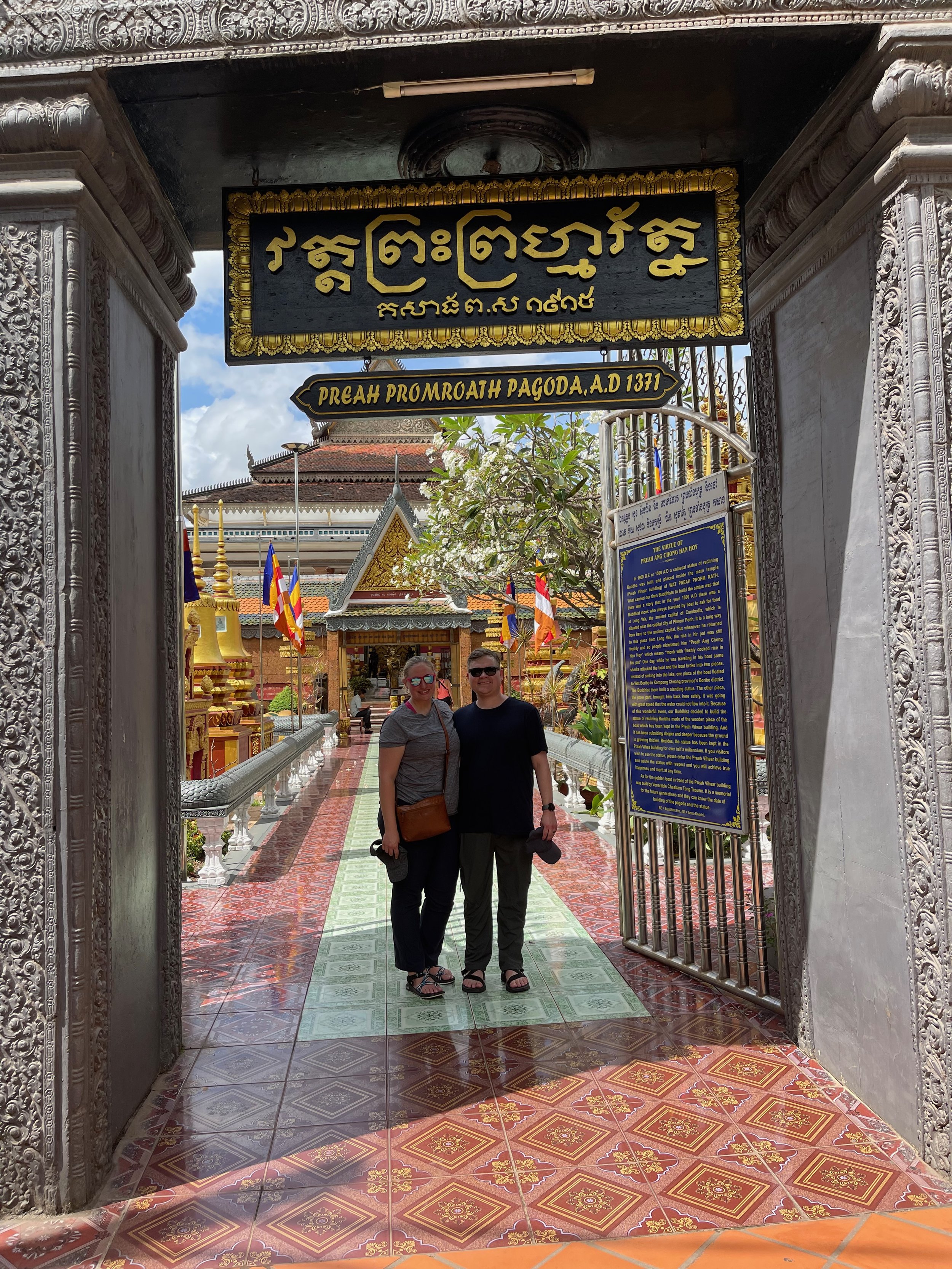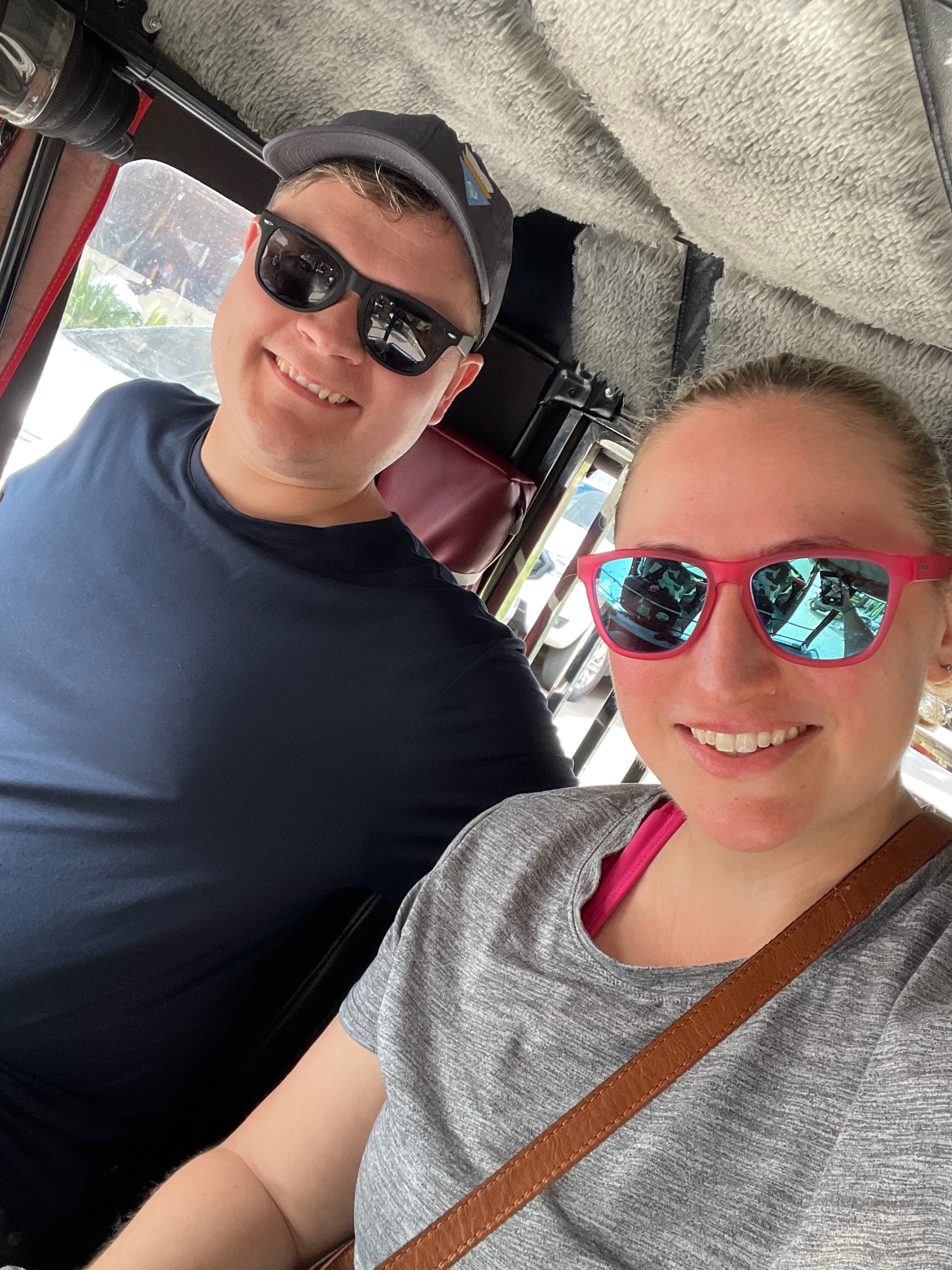Getting Acquainted with Siem Reap
By Lauren Gerzina & Justin Hayes
Pagodas, Museums, and Red Ants
We did it right this time – we started our journey in Siem Reap with a walking tour of the city to become familiar with our surroundings.
Our day started off with some breakfast in the hotel (our Airbnb included free breakfast, which was buffet style on the top floor). Luckily, it included soup and omelets – our favorites while traveling SE Asia. After breakfast, we walked about five minutes to a local coffee shop where we met up with a private tour guide, Long. Long took us through the local market and showed us all the different produce/meats that Cambodians grow/eat regularly.
There was a LOT of live fish jumping around which apparently came from local lakes (many looked like catfish). As one might imagine, the market smelled . . . less than fantastic. After, he led us to a large Buddhist pagoda that had many buildings for children (dorms, school buildings, etc) and the temple Wat Damnak. He taught us a lot about Buddhist beliefs and how this religion affects Cambodians’ every day lives. It was a very peaceful area with many beautiful statues of Buddha and Stupas (ornate shrines where people’s ashes are placed once they die). He also told us about how pagodas provide education and teach people the Buddhist language Pali.
After leaving this pagoda, we walked to the other side of the river to another Pagoda and to see Wat Preah Prom Rath temple. Here, Long told us the story of a king who saw suffering of his people and decided to give up his way of life to become a devout Buddhist. This pagoda had many colorful statues depicting the king and the story he told.
It started to get very hot, so we stopped at a small café to cool off and got some waters and fresh fruit to eat. Long told us about his desire to travel abroad, and specifically to get a scholarship to study in the US or UK. He has never left Cambodia yet had many strong ideas about how he thinks many government officials are not doing the right thing for the Cambodian people, and how he thinks things should be improved. He had similar thoughts about many of the monks that were not practicing Buddhism properly. He seemed to be very smart, deeply religious, and non-conformist.
After our break, we walked on a beautiful sidewalk (these barely exist in SE Asia) along the Siem Reap River. He continued to tell us stories about the Buddhist faith, which became slightly confusing as he started to also add in Hindu gods to the discussion. We realized rather quickly that there were WAY too many religious stories of many, many different gods, and we could not keep them all straight from his lessons.
We finally arrived at the Kings residence in Siem Reap (the king barely stays there, and instead lives in the palace in Phnom Penh). The residence was smaller than expected, but it had a beautiful garden in front of it and of course a temple.
We walked through the area and out to a main square where Long told us to look up. In 1 row of trees of this square, there were tons and tons of bats, all making noise. We were both surprised to see them up there. They seemed to only like the trees in this one row, and not the other. Very puzzling.
This was basically the end of our tour, so we tipped Long and walked into the nearby Starbucks for some A/C, WiFi, and cold drinks. Long had told us that we should check out the Angkor National Museum before heading to Angkor Wat the next day, so we made plans to eat lunch and then head over there for our history lesson.
There were not a lot of food options in the area, so we walked about 10 minutes over to a Mexcian restaurant! The inside of the restaurant (Maybe Later) was fully painted with skeletons and day of the dead-looking décor. Luckily, it was Tuesday, so we got to celebrate Taco Tuesday with cheaper tacos and margs! The menu said they had GF Flour tortillas which made Lauren a bit nervous for Justin . . . especially since the tortillas were REALLY good (and didn’t seem to be corn tortillas). But they ended up being GF and delicious.
After lunch, we hailed another tuk tuk and went to the Angkor National Museum. Even the ride over to the museum was so hot, we immediately went to the café inside to buy water. And then found out that we couldn’t enter the museum with the waters – so we had to chug them to start our visit. We bought the audio guides, which were so helpful in understanding context to many of the artifacts.
The museum was split into several exhibits, including one room with one thousand Buddha statues and a longer exhibit that goes through the various rulers of the Khmer Empire, the largest civilization in Southeast Asia at the time. In the Thousand Buddha Statue room, we learned about the meanings of their different positions and hand gestures.
In the Khmer Empire exhibits, we were introduced to many of the Hindu gods – and learned that Angkor Wat was dedicated to the Hindu god Vishnu (the preserver). We also learned about the Khmer people (the main people of Cambodia) throughout different periods of the Empire. The museum did a full deep dive of the stories depicted in Angkor Wat and what could be seen in different parts of the Angkor Wat temple – including all the symbology we would see. For instance, in some of the pictures below, you may see a five-headed snake, which is the Naga. There are also female dancers called Apsaras.
Throughout this walkthrough, they also explained that as different kings took the throne, their religious beliefs affected what happened to Angkor Wat – specifically which religious iconography would be on display. Angkor Wat was built by the Khmer King Suryavarman II in the first half of the 12th century, around the year 1110-1150. The temple complex, built in the capital of the Khmer Empire, took approximately 30 years to build (and, later we would learn, approximately 300,000 people). He was Hindu and dedicated the temple to Vishnu, so the temple depicted Hindu gods and stories on every wall, column, statue, etc. However, after he died, Jayavarman VII (1181–1215), worked tirelessly to establish Buddhism as the state religion of Angkor. He changed out all of the Hindu statues for Buddhist statues and built many more temples in the Angkor area that were dedicated to Buddha, including the Bayon temple.
The museum is definitely worth visiting before you go to Angkor Wat and other temples. It significantly helps with understanding the time periods in which the temples were built as well as identifying the various religious iconography that you will see.
After we finished at the museum, we headed back to the hotel to relax for a bit and take a dip in the rooftop pool. The water was actually sort of warm, but it was nice to cool off after a hot day of walking around.
We then headed out for dinner. We tried to go to a restaurant called Chanrey Tree but it was fully booked, so we went to the Sokkhak River Lounge, its sister restaurant (with pretty much the same food). We ordered an appetizer with red ants and pounded chicken. Justin got an entrée with minced pork and Khmer fermented fish that was delicious. Lauren had a beef fried rice. They made both gluten free so Justin could try everything.
It was definitely one of the fancier restaurants in town, but it still wasn’t crazy expensive, especially compared to what you would pay in the states.
We knew we had an early start ahead of us for the next day Angkor Wat sunrise tour, so we decided to head back to the hotel and get some sleep.





































































